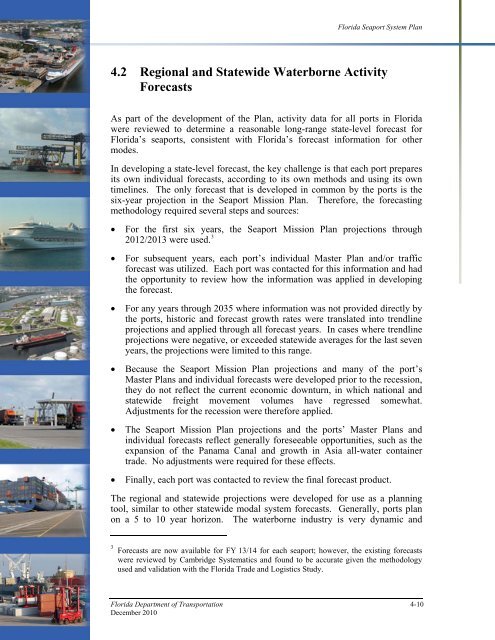Florida Seaport System Plan - SeaCIP
Florida Seaport System Plan - SeaCIP
Florida Seaport System Plan - SeaCIP
Create successful ePaper yourself
Turn your PDF publications into a flip-book with our unique Google optimized e-Paper software.
<strong>Florida</strong> <strong>Seaport</strong> <strong>System</strong> <strong>Plan</strong><br />
4.2 Regional and Statewide Waterborne Activity<br />
Forecasts<br />
As part of the development of the <strong>Plan</strong>, activity data for all ports in <strong>Florida</strong><br />
were reviewed to determine a reasonable long-range state-level forecast for<br />
<strong>Florida</strong>’s seaports, consistent with <strong>Florida</strong>’s forecast information for other<br />
modes.<br />
In developing a state-level forecast, the key challenge is that each port prepares<br />
its own individual forecasts, according to its own methods and using its own<br />
timelines. The only forecast that is developed in common by the ports is the<br />
six-year projection in the <strong>Seaport</strong> Mission <strong>Plan</strong>. Therefore, the forecasting<br />
methodology required several steps and sources:<br />
• For the first six years, the <strong>Seaport</strong> Mission <strong>Plan</strong> projections through<br />
2012/2013 were used. 3<br />
• For subsequent years, each port’s individual Master <strong>Plan</strong> and/or traffic<br />
forecast was utilized. Each port was contacted for this information and had<br />
the opportunity to review how the information was applied in developing<br />
the forecast.<br />
• For any years through 2035 where information was not provided directly by<br />
the ports, historic and forecast growth rates were translated into trendline<br />
projections and applied through all forecast years. In cases where trendline<br />
projections were negative, or exceeded statewide averages for the last seven<br />
years, the projections were limited to this range.<br />
• Because the <strong>Seaport</strong> Mission <strong>Plan</strong> projections and many of the port’s<br />
Master <strong>Plan</strong>s and individual forecasts were developed prior to the recession,<br />
they do not reflect the current economic downturn, in which national and<br />
statewide freight movement volumes have regressed somewhat.<br />
Adjustments for the recession were therefore applied.<br />
• The <strong>Seaport</strong> Mission <strong>Plan</strong> projections and the ports’ Master <strong>Plan</strong>s and<br />
individual forecasts reflect generally foreseeable opportunities, such as the<br />
expansion of the Panama Canal and growth in Asia all-water container<br />
trade. No adjustments were required for these effects.<br />
• Finally, each port was contacted to review the final forecast product.<br />
The regional and statewide projections were developed for use as a planning<br />
tool, similar to other statewide modal system forecasts. Generally, ports plan<br />
on a 5 to 10 year horizon. The waterborne industry is very dynamic and<br />
3<br />
Forecasts are now available for FY 13/14 for each seaport; however, the existing forecasts<br />
were reviewed by Cambridge <strong>System</strong>atics and found to be accurate given the methodology<br />
used and validation with the <strong>Florida</strong> Trade and Logistics Study.<br />
<strong>Florida</strong> Department of Transportation 4-10<br />
December 2010
















